Hickory nut milk (hick milk for short) is the best nut milk I've ever tasted, and, unfortunately for non-foragers, I doubt it will ever be on a store shelf. It's hard to put into words how fascinating it is, and, to be honest, to me, the name nut milk undersells the product, as well as the deep cultural history hidden within it.
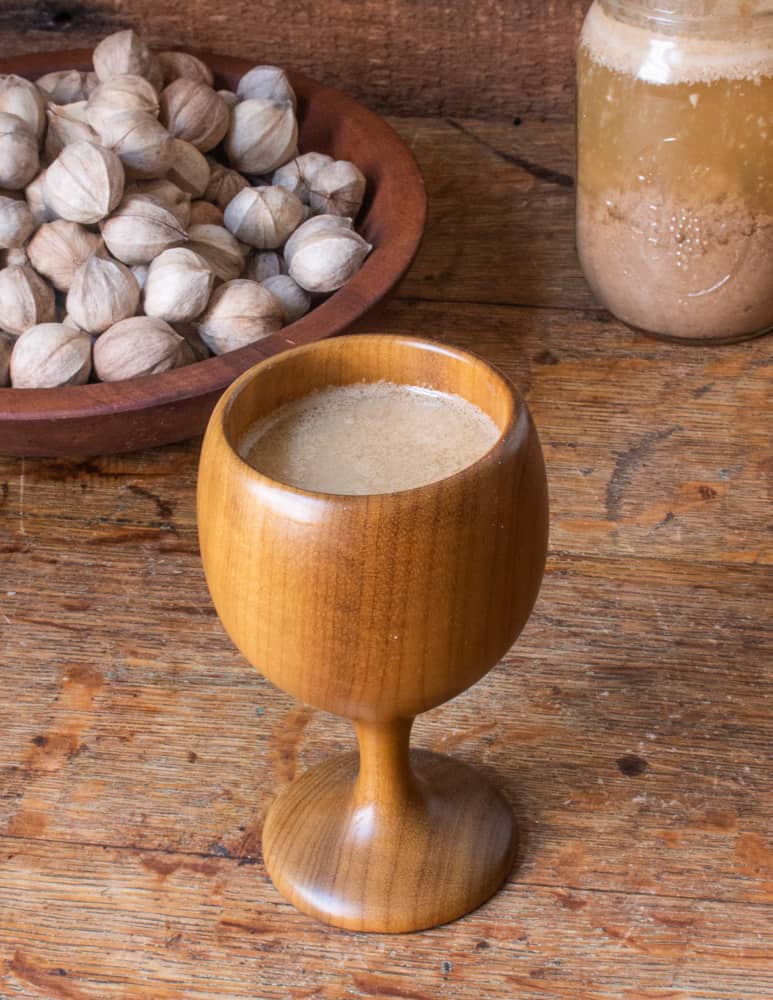
Comparing hickory nut milk to something like a carton of almond milk, is like comparing truffles to button mushrooms. They are not the same.
Kanuchi, the Cherokee name for a sort of ball of pounded hickory nut meats and shells the milk is derived from, is probably the best known, ancestral name.
To truly appreciate what it is, and to understand why I'd hype up a glass of brown nut water, kanuchi is a word you need to know. Below is a great video of Cherokee elder Edith Knight making her kanuchi that my friend, Cherokee Chef Niko Albert turned me onto-definitely give it a watch!
A wasi'chu myself, I'm not an expert on the history of Kanuchi by any stretch of the word, but I've made enough of it to describe the process, especially after watching Sam Thayer demonstrate it at a solstice party we had a few years back. Sam also describes the hick milk process in his book Incredible Wild Edibles that I consulted regularly while working on the section of my book on hickory nuts.

At the party, Sam walked up to the house carrying a bootagen-a length of birch trunk, (as I understand it, birch is less prone to splitting than other woods). The log is slowly, painstakingly hollowed out using a progressive fire technique, making it essentially a large mortar and pestle, Sam's pestle was a long stick about the size of a canoe paddle or a boat oar (see below).
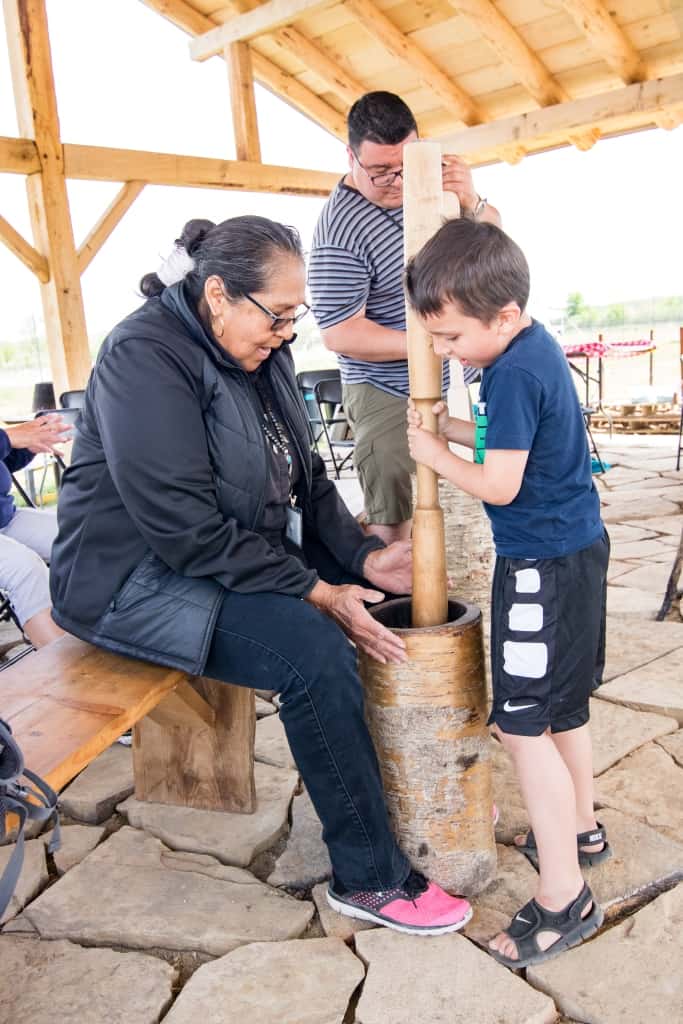
Sam cracked some nuts, each one individually to check for any rancid nuts (which can be a real issue with hickory nuts, as I've come to find out) then, in one of the most impressive demonstrations of ancestral food I've seen, proceeded to pound the nuts, shells and all, into a sort of coarse paste in the tree trunk mortar with the sort of force that made the floor of the house shake with each strike of the massive pestle. It was a showstopper, to be sure.
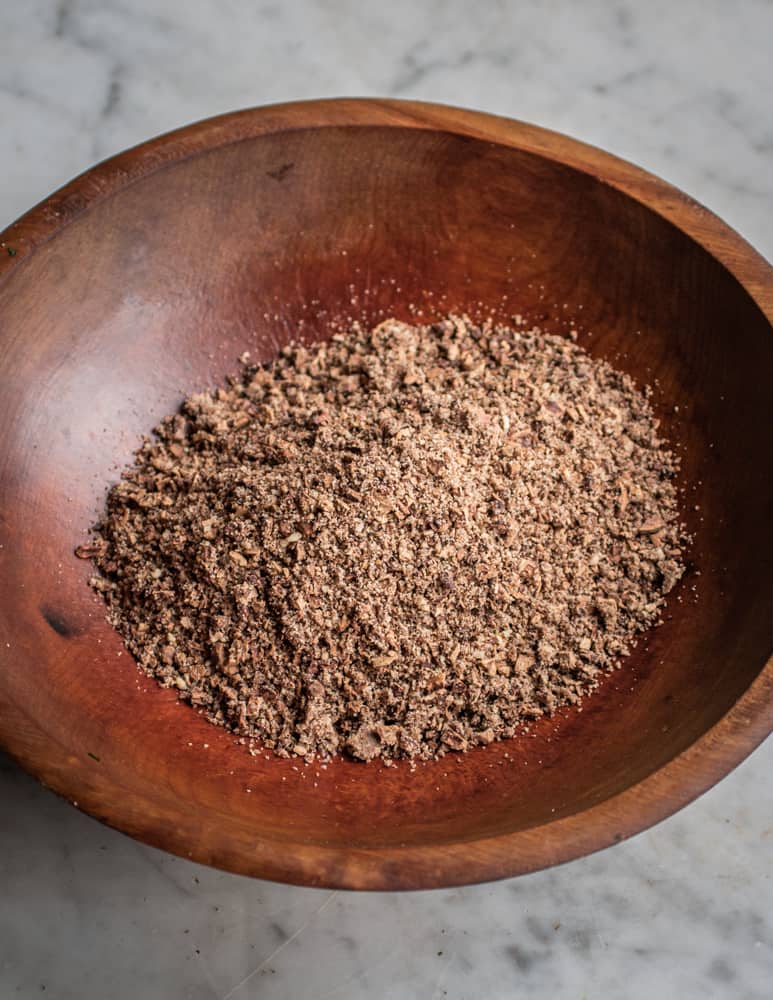
After the nuts and shells are pounded into a mash (I use a Vitamix dry bowl, and it's loud, but it works) they're traditionally made into a ball, which I've heard could be given as a gift.
To prepare the hick milk, the mashed nuts and shells and added to water and simmered for a while, releasing an unmistakable aroma of pure, buttery hickory-pecan-esque goodness into the air.
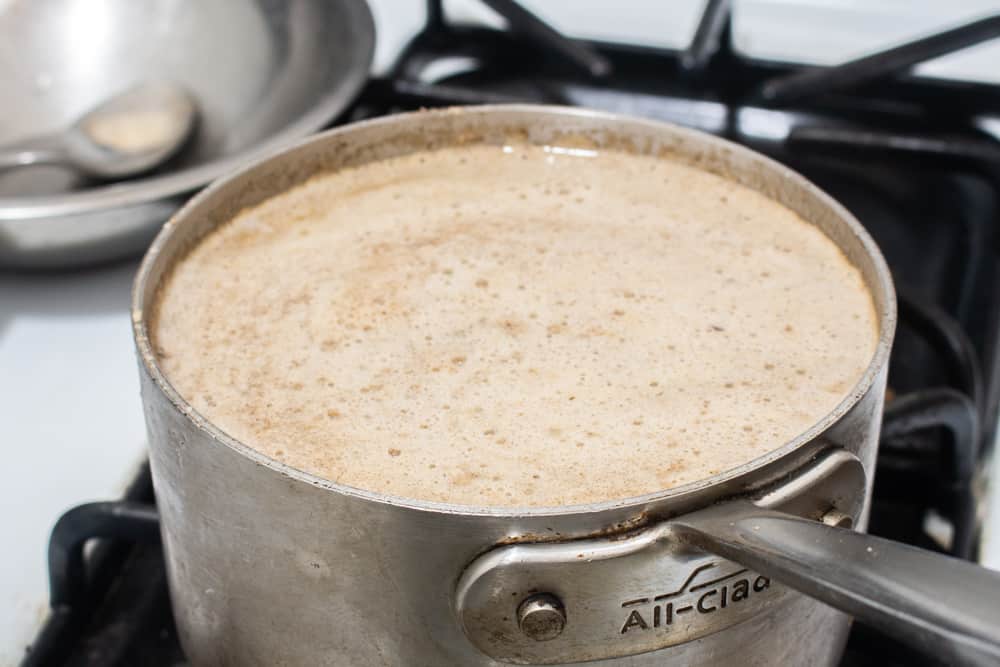
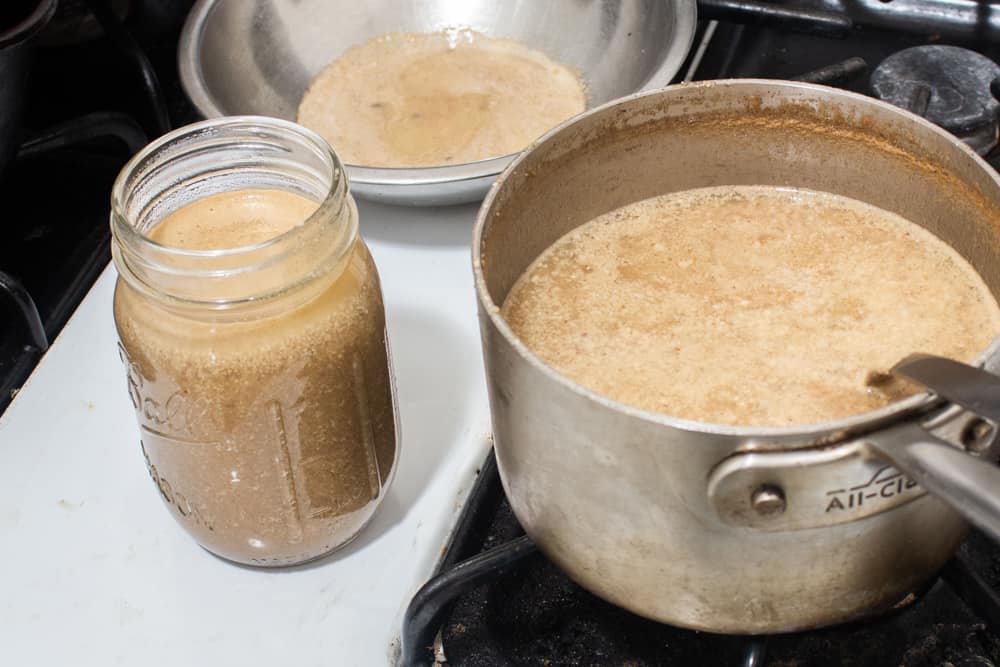
After simmering is when the magic happens. Once the nut milk has cooked for a bit and has a good flavor, you stir the pot, then stop for a few seconds. Once you stop stirring, the hickory nut shells, being more dense than the nut meats, sink to the bottom, and the resulting, semi-chunky nut milk is ladled off into another dish, or into cups.
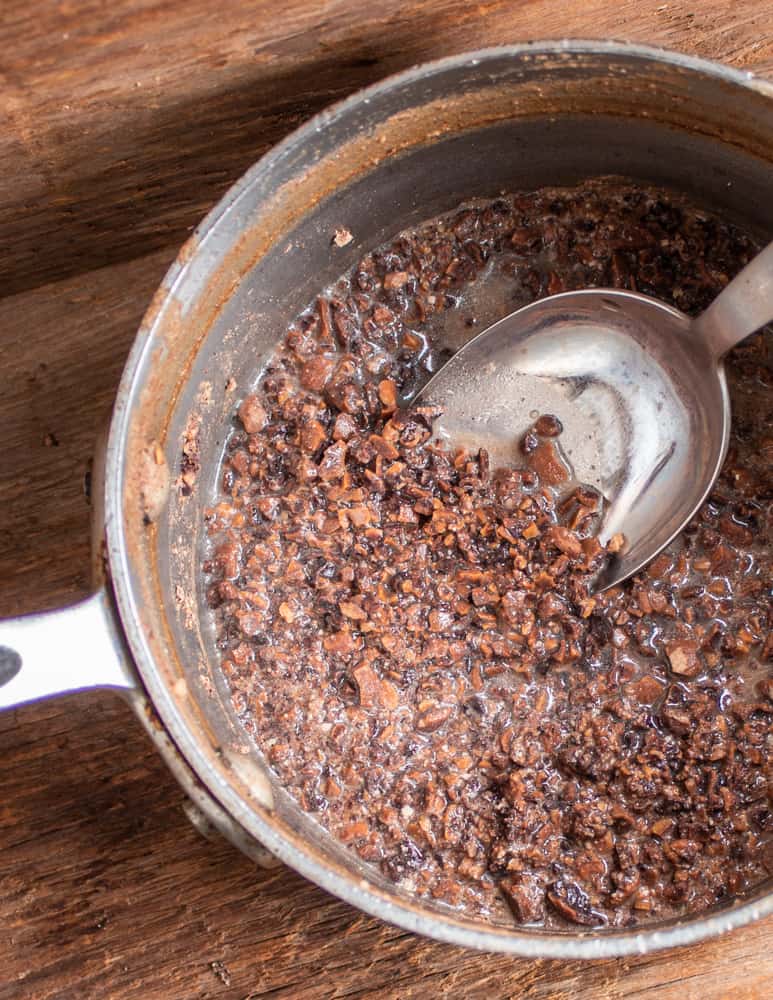
Seasoned with a pinch of maple syrup and a dash of cinnamon, it's a nectar of the gods, and, if you're like me, you'll never think of nut milk the same way after your first taste. I mean really, from a practical standpoint, an indigenous non-animal fat source derived from hickory nuts that bypasses the tedious shelling process is pure genius, right?
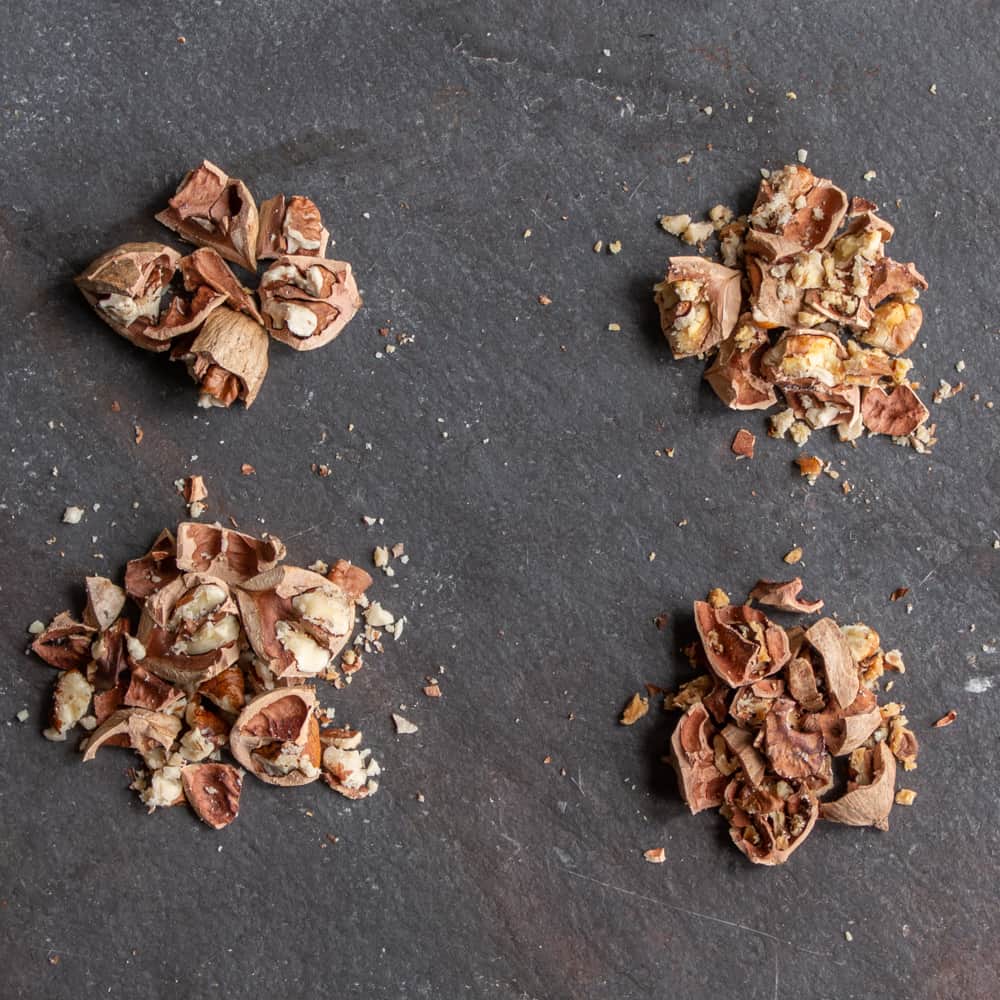
The second wash
After the nut milk is ladled off of the settled shells at the bottom of the pot, it's ready to go, but you're not done yet. As Sam writes, there's still plenty of delicious hickory nut solutes in the pot that you can harvest by adding some more water, simmering again to make a weaker, but still useful second wash as I call it (a term I would use with my cooks for when we were going to make a remoulage-a stock made from bones that had already been simmered once).
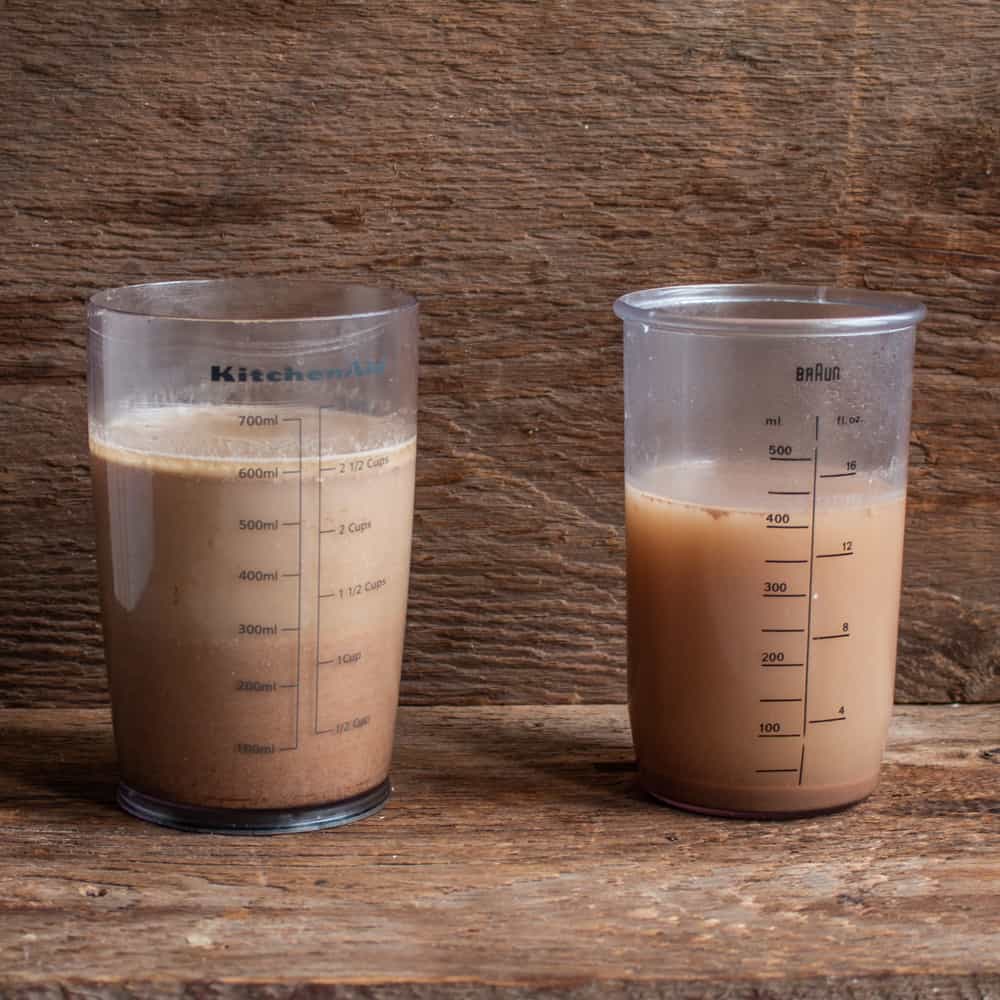
The second nut milk has different properties than the first wash in that it's not thick. The lack of thickness means it's great for using as the base of a soup, or, arguably the best: cooking a pot of real wild rice.
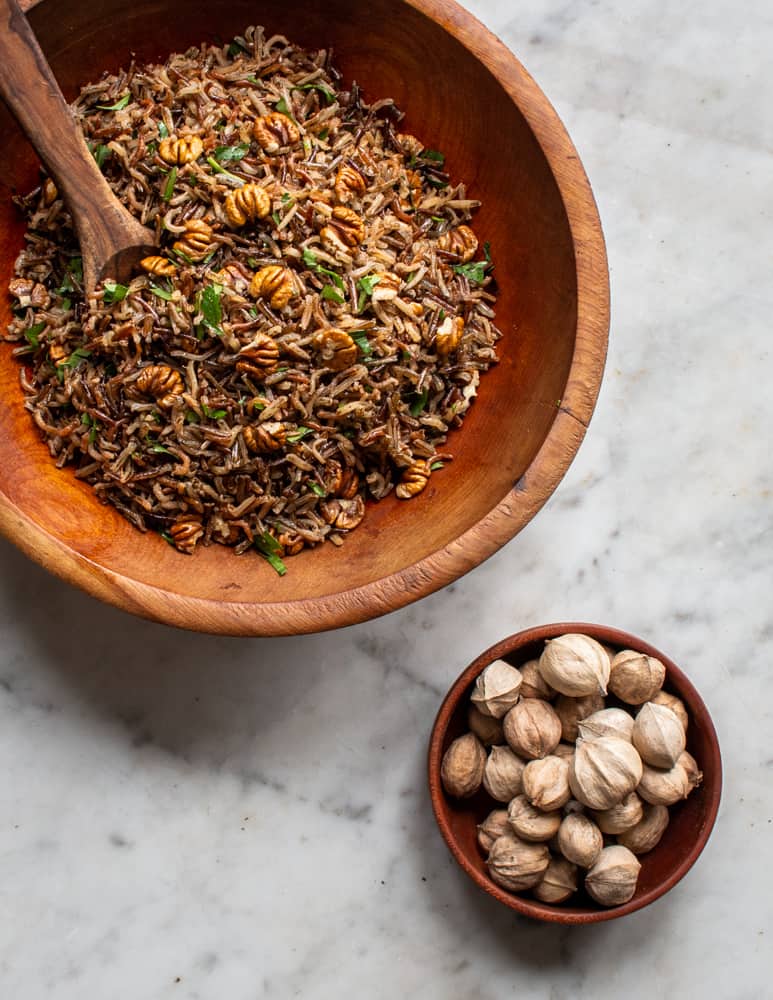
What follows is the beginner version of hickory nut milk I developed and, compared to with other recipes, it will seem like a small batch for the amount of work involved—and it is. Once you get the hang of cracking the nuts and inspecting them for off ones, I’d encourage you to make larger batches.

Related Posts
How to Make Traditional Hickory Nut Milk (Kanuchi)
Ingredients
- 8 ounces 225 g crushed hickory nuts and shells
- 4 ¼ cups 1 L water
- Serving
- Maple syrup to taste
- Cinnamon a pinch
Instructions
- Crack each nut individually, inspect for (and discarding) any that smell off, are hollow, or have dark interiors. Take the cracked nuts and put them in a high-speed blender and process into a coarse meal—it will be loud. Add the nut mash to the water and bring to a simmer, stirring occasionally.
- When the pan starts to simmer, a raft of frothy nut cream will form on the top. Virtually all of the shell particles sink, but inevitably some will be caught in the foamy cream, so I like to spoon this off and add it to the “second wash” for extra flavor, and to remove nut shells from the finished milk.
- After you’ve skimmed the foam, let the mixture simmer for another 15 minutes or so, then turn off the heat, wait a few seconds to let the larger shell pieces fall to the bottom, and start ladling off nut milk.
- There’s a real art to ladling off the milk; you want to wait just long enough to let the large shell pieces settle, but not so long all the nut meats go with them.
- Gently swirl the pan a bit, and you’ll get the hang of it. Eventually you’ll need to tilt the pan to continue scooping off nut milk, but don’t try to get it all or you’ll get shell particles.
- Season the finished nut milk with maple syrup to taste and a tiny pinch of cinnamon.
- Save the remaining nut meats and milk to make the second wash—a weaker nut milk that’s perfect for cooking rice or, polenta, or as the base of a soup, since it’s not thick like the first milk. Squirrel soup cooked with nut milk is delicious, and makes me chuckle.

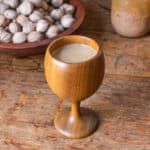
Oliver
I tried making this, using just the ground up nuts and no shells because I already shelled all my nuts. I don't know if I did something wrong, maybe I made it too thick, but after simmering for a while the nut milk started to become almost gelatinous, it was thick and gloopy, almost like the texture of thickened cornstarch. It was still liquid but it was almost... Mucus like? The smell was amazing. The taste was good but didn't have a very strong flavour, it was a bit disappointing 🙁 maybe the flavour comes from the shells?
Alan Bergo
Hi Oliver, this is a very traditional recipe. What you're talking about can come from grinding the nuts too much in the vitamix, if that's what you're using. The ideal way is to use a bootegen, but they're extremely difficult to get if you don't make your own. This is the best approximation I have for it though. Just thin it a bit, add a splash of water or some cream and it'll be fine. Don't forget to make the second rounds of milk for cooking a pot of rice too.
John Paul
A couple questions:
1. My solution has separated into three pretty distinct layers. The top layer looks like it's made of nut meat and oil. The middle layer looks like light brown water. And the bottom layer is made of really tiny pieces of what I assume are nut meats and maybe shells; the pieces are too small to tell My question is if they are all edible of if I'd want to avoid the bottom layer. Or would I just mix everything up before I serve it.
2. The milk is pretty good, but also pretty watery. Is that the way it's supposed to be or should I have simmered it longer to make it more concentrated?
Alan Bergo
Hi John. Making hick milk is a learned skill, the first few ladles may include some small shell pieces, especially if you didn't skim it much. I usually drink the first glass myself. It's supposed to be watery, I mean it's just nuts mixed with water. If you want it thick, you can puree it and strain, or reduce it down. But, the quantities here are a good place to start. Traditionally it's served chunky, and you could sip it and then eat the nuts with a spoon at the end. Don't be expecting something like almond milk from the store, traditionally it's a very rustic drink.
John Paul
When pulverizing the hickory nut pieces in the blender at what point would you stop blending? Or maybe a better question is if it's possible to blend the nuts/shells into to fine of a mixture? I blended mine using a Vitamix for about 45 seconds and about 70% of the results are in a coarse meal, but the remaining 25% still contains large-ish pieces of the shell.
Alan Bergo
It’s ok if they’re not totally broken up. You can also do smaller batches. Ideally it’s done in a bootagen, if you don’t make your own they’re kinda hard to find though.
Lisa B.
Soon after moving into our house, we discovered that we have lots and lots of hickory nuts. My husband gathered up a big basketful with all ideas of the bounty we would soon enjoy...until he tried cracking them. The only method to produce results was placing one on a rock and smacking it repeatedly with a hammer. The miniscule bits of meat embedded within seemingly solid stone soon discouraged him, and the basket was left abandoned on the patio--where the squirrels soon discovered it.
SO MUCH FUN to watch a fuzzy little head pop up over the edge of the patio and glance nervously left and right, spying to see if the coast was clear. One squirrel at a time braved the mad dash to the basket to steal a single nut and flee. It must have taken them most of a month to empty that basket.
So, you can imagine my excitement to find out about Kanuchi! Much thanks.
Alan Bergo
Thanks Lisa.
Lanie
Hello Alan! I'm excited to try this recipe. I live in upstate NY and we have a TON of shag bark hickories this year. I drink macadamia nut milk which I'm sure is shipped from far away.
2 questions:
1. I don't have a food processor to "pulverize" the hickories. Do you think a hammer would work?
2. Is this milk something you enjoy right away, or can you freeze it for later?
Thank you kindly!
Lanie
Alan Bergo
You can absolutely use a hammer, but you'll want to make sure you have some sort of container (people used to use a chiseled out stump) to pound them in. It's fine to freeze it and I've done that before.
Lanie
Ahh, I see! I wish I had wood working skills. 🙂 Last question -- do you freeze the hick milk, or the pulp? (for making another hick milk batch later) Thanks!
Alan Bergo
You sure could.
Kim Schumaker
I tried this and love it! I even share the recipe with my Permaculture group and they all came over for a mushroom presentation and also got to forage nuts right off of my property since I have dozens of mature, hickory trees. It was a hit!
My favorites are to use the hickory nut milk in smoothies and I also made a hickory milk pumpkin pie substituting the dairy with the hickory nut milk and it was delicious!
Alan Bergo
Thanks Kim. It's so great for parties and gatherings isn't it?
Ann Bliss-Pilcher
Hi Alan,
Wow. I made your hickory nut tea, it's absolutely delicious. I had some nuts in the freezer from last year....I'd been putting off the arduous task of shelling them. Your recipe could not have been easier. I used a little less water to intensify the flavor. Your addition of heavy cream, maple syrup and cinnamon was perfect. For smashing the nuts, I put one nut at a time inside of a masking tape roll, which I found works really well to contain the nut and keep it from flying all over the place when I smash it. Thank you for being so generous with your knowledge and enthusiasm which you give freely.
Alan Bergo
Thanks Ann. Glad it worked for you.
Erik Cushman
After battling the squirrels, I was able to gather enough nuts to create this wonderful drink. The recipe was very easy to follow and I appreciated the historical background on this beverage. And you are correct, it blows away the flavorless "nut" liquids you buy at your local hippie store. Delicious. The one thing I did, that I feel produced excellent results, was using a finely mesh coffee filter to filter out my first batch of hickory milk. Keeps solids out of the drink. One could use cheese cloth as well....
Alan Bergo
Thanks Eric. It’s almost time up here. It is not traditional to use a filter and the milk is supposed to have chunks in it. Nothing wrong with straining though and I do it sometimes.
Confused
You have very creative spelling and word-conjuring skills.
Alan Bergo
Sometimes I think people like to comment just to see their words on a screen.
Donna Munro
I want to try this but am afraid I’ll bust my blender-those shells are hard! Do you think it would help to boil them a bit first and then grind them? Have you tried that?
sasha
Other recipes have mentioned that boiling them first can create a bitter taste. It's probably worth experimenting, though. Maybe there's a balance where you can soften them a little and not get a noticeable amount of bitterness? 🙂
Sheila
Any tips for cracking the nuts? My grandfather had the patience to pick out the nut meats, I don't!
Alan Bergo
Use a Grandpa's Goodie Getter cracker with the hickory nut attachment. I don't crack them myself, I only really make the milk because it's so much easier.
TerriO
SO glad I found this recipe! I have a whole bucket of Hickory nuts that I was dreading the shelling process.
Sheila
I make a hickory nut "tea" that is one of the single best hot beverages I've ever had. Roughly cracked hickory nuts, water, large Dutch oven, woodstove, 24 hours, shells sink, nutmeats float. Makes a dark, rich drink. I am definitely going to try this as the grinding step will take it to the next level and give it that milky quality.
Do you see any reason the process above wouldn't work with American hazelnuts or acorns (after leaching), SHELL and all? I have many producing bushes and trees. This would be a fantastic use for them, in my mind. The little digging I've done has given me no information on the use of the shells except for mulch and compost.
Thanks so much!
Alan Bergo
That tea sounds really good.
Donna munro
Would you strain the second wash thru cheesecloth?
Sounds good though, hickory nuts are hard to get at .
Alan Bergo
You sure can.
T
Wonderful! Tsi Tsalagi (I am Cherokee). I live in the Pacific Northwest and me and my group are always trying to think of a good substitute in the land of filberts. Do you have any ideas? I am new to your site, but I love the recipes and ideas for foraging. Thank you.
Alan Bergo
Wado, T. Hmm. I don’t know a real substitute for filberts. I know you have bay nuts there, but they’re tricky to work with.
Deaonna Crowe
You are grinding the whole hickory nut shell and all.
Alan Bergo
Yes. Grinding the entire nut bypasses the shelling process, and is traditional.
Lora Louderback
I've been making and sealing Shagbark Hickory Syrup for 3 years now! My family and friends love it! I bake lots of banana nut bread with the larger nut meats and I am about to try making hick nut butter. I think I will have to try making Kanuchi now too! After the ball is formed, do you have any tips on storing them before making the soup or is freezing them in foil the best way?? Thank you so much for sharing your knowledge!!
Alan Bergo
Lora, you'll want to freeze the nuts. If you haven't looked over Shagbark Hickory Nuts: Harvesting, Cracking and Cooking I go over storing in there. Long story short dried hickory nuts must be frozen as they go rancid faster than other nuts.